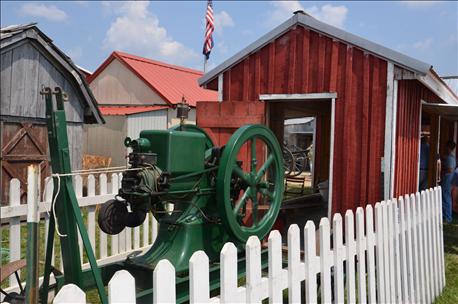
You may walk through Pioneer Village at the Indiana State Fair in the not-so-distant future and see a 50-pound bag of soybean seed sitting there as an example of the way farming used to be. And the bag, either full or empty, will bear modern logos, not those of seed companies that no longer exist.

MAKE SPACE FOR 500-POUND BAGS: Think you will never see a modern soybean seed bag resting alongside other relics at the Indiana State Fair? Don’t bet money against it!
Why? Because fewer and fewer people are buying soybean seed in 50-pound bags, Kevin Adams says. Adams, the Indiana Certified Crop Adviser of the Year, is seed manager for Corp Production services in the region encompassing the northern half of Indiana plus southeast Indiana. He works with 23 CPS retailers, serves 25 farmers directly as their seed consultant and is responsible for three bulk soybean seed treating facilities in his area. The CPS strategy is to start with untreated soybean seed, and add seed treatments selected by the customer.
Adams says roughly 5% of the seed sold by CPS in his region of northern and southeast Indiana will ship out in 50 pound bags this year. That’s 50 pounds out of every 1,000 pounds of seed shipped for planting is in 50 pound bags. Or put another way, 950 pounds out of every 1,000 pounds CPS in Adams’ region delivers arrives at the farm in some form besides 50 pound paper or plastic bags.
Follow that rabbit down the trial, and one in 20 acres, will be planted with seed from bags. It’s a far cry from not that many years ago when big bulk soybean bags were an innovation! Then came heavy-duty plastic boxes, and seed tenders fitted for boxes to haul to the field. That system is still popular today. Someday 2,000 pound large bulk bags may follow 50-pound bags to Pioneer Village. Adams says the trend is toward true bulk delivery and handling of soybean seed.
That’s a far cry from the day when I hoisted burlap bags of soybeans from the pickup into planter boxes on our old John Deere 494A planter. Since we were saving our own seed back then and having it cleaned and bagged by an old guy driving a dilapidated truck with an old seed cleaner on the back from farm to farm. Sometimes the bags had more like 60 pounds of seed inside. To a gangly 12-year old, they seemed like they weighed 100 pounds each.
Think farming hasn’t changed? Just look at how soybean seed handling has changed in your lifetime. And according to Adams, the changes are still coming. If you still buy in 50 pound bags, you might want to stick an empty bag away for safekeeping. Who knows? Someday it may be worth more to collectors than the soybean seed that was inside the bag!
About the Author(s)
You May Also Like




